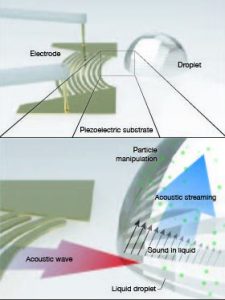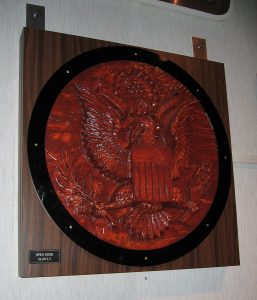Center for Advanced Computation and Telecommunications

This National Science Foundation Innovations in Graduate Education (IGE) award (2021) to the University of Massachusetts Lowell and the University of Massachusetts Dartmouth will pilot a model for co-creation of cross-disciplinary educational content by teams of graduate students, research advisors, instructors and practitioners from industry. The educational model is prototyped considering the topic of cyber-physical systems that are being applied across a wide range of industries spanning the service, manufacturing, health-care, transportation, automation, and smart-system based environmental monitoring sectors. The project will apply evidence based practices from education research on how the curriculum can be inclusive in engaging and educating a diverse student body.
This investigation (2021) is a collaborative project with Univ. of Akron and Ohio State University that aims to explore the role of AI-Assisted Augmented Reality (AR) systems in strengthening STEM education, improving inter-generational communications, and sharing knowledge across disciplines. We will utilize commercial AR devices and explore the systems and process foundations that are necessary to fully utilize such capabilities. In this planning phase, we will assemble an integrative team of educators, subject-matter experts and socio-technical systems engineers to design workflow processes in STEM education and workforce training contexts. A prototype system will be designed to aid in the process of formulating requirements, systems architecture and fully explore the technology options for scalable deployment. This investigation focuses on the systems and processes that are necessary to develop the AR content and integrate the new capabilities into STEM education and workforce training. The team is starting with a robust AR system framework that will support a content database, tools for specifying sequences of instruction, a versatile collection of presentation modalities, and conversational interaction. A novel model for collaborations between university, industry and community stakeholders is proposed. The team will adapt and implement tools from Participatory Action Research, Community-Based Participatory Research, and the Delphi Method to hone research questions and design workflow processes.
This panel explored two student-centered models for engaging industry professionals with students to promote early learning experiences that address entrepreneurship, teamwork, communication skills and mentorship. The Entrepreneurship Center at the University of North Carolina (UNC) Chapel Hill’s Kenan-Flagler Business School offers one example of this work in action — the Eship Scholars program — for other institutions that are looking to implement solutions to support high-potential entrepreneurs from traditionally underrepresented, underserved and underfunded backgrounds. The University of Massachusetts Lowell’s Research, Academics & Mentoring Pathways (RAMP) summer bridge program serves as an example of such a program in the field of engineering, with its focus on helping new female students and students of color be better prepared for the transition from high school to an undergraduate engineering degree program. Student participants from these programs will provide an overview of their experiences. The panel highlighted the various models of interaction between students, entrepreneurs and industry leaders that both Eship and RAMP have implemented.
Nationally, the percentage of females enrolled in engineering degree pathways in four-year public universities has remained in the 15 – 20% range and that number for females who are also students of color is around 5%. With major efforts and financial resources having been applied to address this problem, there is currently a need to carefully identify and assess strategies and models that have demonstrably contributed to the persistence of women in engineering degree pathways. Among such models are the inclusion of counter spaces in STEM environments for underrepresented groups, peer mentors and mentoring opportunities as well as the students’ own agency in creating environments that promote belonging and success in the program. This study is part of a longitudinal effort that begins with a summer program offered to incoming female students in engineering majors and continues with opportunities and support for the participants to become engaged as peer mentors and focus group facilitators in subsequent years. Using the results of a survey on student experiences in engineering majors administered to all students in their junior and senior years, we analyze the responses from participants in the summer program with those from students who did not have this opportunity. We also analyze the agency of those who have participated in the summer program with respect to their engagement in mentoring, leadership roles and efforts in recruiting students and facilitating focus groups. We also use a participatory action research (PAR) approach to examine how student-driven program evaluation processes can be used to formulate action steps for program change and increase sense of belonging, personal agency, and engineering identity among engineering undergraduates.
 The Acoustical Society of America, will publish in 2021 a JASA Special Issue that seeks to address the fundamental science impacting the application of acoustically driven fluid motion. Guest Editors: James Friend (UCSD), Charles Thompson (UML), Kedar Chitale (FloDesign Sonics) and Max Denis (UDC).
The Acoustical Society of America, will publish in 2021 a JASA Special Issue that seeks to address the fundamental science impacting the application of acoustically driven fluid motion. Guest Editors: James Friend (UCSD), Charles Thompson (UML), Kedar Chitale (FloDesign Sonics) and Max Denis (UDC). In 1945 the Soviet Union successfully deployed a passive acoustic transducer into the U.S. Embassy in Moscow . The transducer was hidden inside the seal of the United States, which was presented to U.S. ambassador W. A. Harriman as a gift. This device listened in on conversations inside the U.S. Embassy for seven years before being discovered. The transducer was operational for so long because it contained no batteries or other internal power sources. It is known as the Great Seal Bug or the ‘Thing’.

In this paper entitled, Analysis of a passive radio frequency excited acoustic transducer, authors Lejun Hu, Charles Thompson, Grace Remillard and Kavitha Chandra analyze and model the physical processes that govern the operation of a passive acoustic transducer. The wireless battery-free transducer derives its power from an externally applied electromagnetic field generated by a radio transmitter. The audio signal is encoded in the backscattered electromagnetic field. Electro-Mechano-Acoustical analogies are developed and presented. Power generation, sound transduction and radio frequency backscatter transmission of the audio signal are analyzed. The resonance frequency of the passive acoustic transducer derived from this analysis is similar to other resonance frequencies reported in the literature.
Despite a disruptive year with Covid in 2020, CACT students successfully completed Master’s and Doctoral research and graduated in 2021. Lejun Hu earned his Ph.D defending his thesis on Fault Detection in an Interconnected Water Tank System using a Particle Filter. Dr. Hu is currently a senior software engineering at Teleflex Inc.
Arielle Joasil defended her MS thesis on Simulating the space-time trajectory of aerosol droplets. Arielle is currently pursuing a Ph.D at Columbia University.
Habibat Olimi defended her MS thesis on and is currently employed in Intel Corporation.
Flore Stécie Norcéide received her BS degree in Electrical Engineering and is currently pursuing her Ph.D at UMASS Lowell.
At the 169th Meeting of the Acoustical Society of America, a special session Acoustofluidics: Interaction of Acoustics and Fluid Dynamic Phenomena Cochaired by Charles Thompson and Max Denis convened. The topics included Acoustic tweezers, steady streaming, and surface acoustic wave microfluidics. The following were invited Speakers: James Friend (University of California-San Diego, La Jolla, CA), Tony Jun Huang (The Pennsylvania State University, University Park, PA), Sadhal Satwindar (University of Southern California, Los Angeles, CA), Charles Thompson (University of Massachusetts Lowell, Lowell, MA), Siew-Wan OHL (Institute of High Performance Computing, Fusionopolis Way, Singapore).